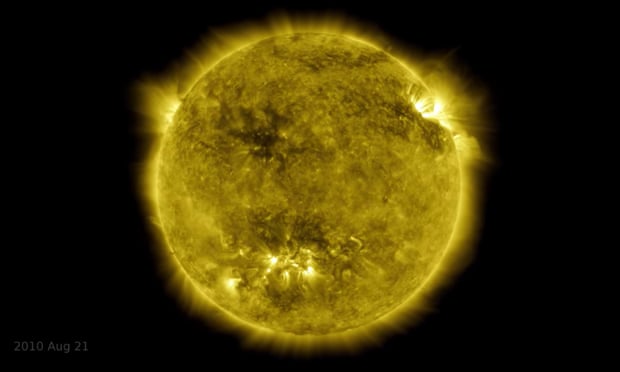quote=Bubblecar]
The space agency gathered 425 million high-resolution images of the sun, which have now been stitched together to form the video.
Nasa has released a mesmerising timelapse video of the sun that condenses an entire solar cycle into an hour of footage, using images of the star taken every hour continuously over a decade.
Nasa’s Solar Dynamics Observatory has gathered 425 million high-resolution images of the sun, from its launch in February 2010 until June this year, which have now been stitched together to form the video.
While the 20 million gigabytes of picture data captured over the decade have contributed to “countless new discoveries about the workings” of the sun, according to Nasa, the images have now been arranged into a 61-minute video showing events including transiting planets and eruptions.
Video: A Decade of Sun
https://www.youtube.com/watch?v=l3QQQu7QLoM
Article:
https://www.theguardian.com/science/2020/jul/01/ten-years-of-the-sun-in-one-hour-nasa-releases-mesmerising-space-film

mollwollfumble said:
I wish they had used interpolation and repositioning to get rid of the bad frames.
What I find most fascinating are the dark features. There are spikes that are so dark that they obscure the flares beyond. There are dark chasms that survive for quite a few rotations and sometimes have a spark that travels the twists and turns of the whole length. And there are the wave fields of light and dark in some quiet regions that are up to half a radius long and wide that waves travel through.
The dark spikes and canyons seem to be related. So perhaps the canyons aren’t canyons at all, but high clouds of dust. That could make the winding flashes along the centres of the canyons actual stellar lightning and unrelated to normal solar flares or spicules.
Perhaps I can add some times so you can spot these dark features for yourself. Over the longer term it’s interesting to compare the periods of quiet sun to Sun with lots of sunspots.
Quiet Sun – 47:07 to end of video
Dark spikes, eg. 0:33 at the 10 o’clock and 2 o’clock positions near the edge.
1:00 to 1:05 at the 10 o’clock position.
Small dark spikes associated with a “canyon” 2:47 at the 10 o’clock position.
Also 9:54 to 9:57 at the 10 o’clock position.
Also 10:36 to 10:44 at the 5 o’clock position.
Dark and light wave field rapidly moving north 1:10 to 1:12 across the whole way from the 11 o’clock position to the 2 o’clock position.
Lightning along a “canyon” at 7:55 at the 2 o’clock position but not near the edge. Notice how the lightning causes a wave field and also how it destroys the “canyon”. The canyon to watch appears as a dark linear feature with narrow winding light centreline at 7:53 NE of centre running top left to bottom right.
Whoa, look at the equatorial flashes from 13:17 to 13:24. It starts looking like a bright z-shaped flash between sunspots north and south of the equator left of centre screen. The canyon is aligned with the equator. Then multiple lightning flashes along the canyon. By the end you can see small dark/light spikes from the canyon as it disappears over the edge at the 3 o’clock position.
I take it you’ve noticed how when the Sun is most active, the sunspots form in bands, one could almost say ‘chains’ north and south of the equator.
I wonder what the correct scientific names are for what I’ve so loosely called “canyon”, “dark spikes”, “lightning” and “wave field”.
“Canyon”
A dark linear feature, often with a jagged central line that is lighter and very thin side to side.
“Lightning”
Flashes of light along this very thin central line. It can be faint and almost continuous, localised, can zoom from one end of the line to the other like a speeding car on the highway, or go bang all at once.
“Dark spikes”
Vertical pillars of dust dark enough to obscure sunspots and spicules behind. These tend to be, and may always be, vertical upward extensions of the thin jagged centre line of the canyon.
“Wave field”
A relatively rare and fast oscillation of dark and light that can travel in any direction. It can be set off by lightning in a canyon, but more often from no obvious cause. The distance between crest and trough is typically 0.1 solar radii, lengthwise they can be as long as 1 solar radius. Most easily visible on a quiet Sun but can occur at any time of the sunspot cycle.
